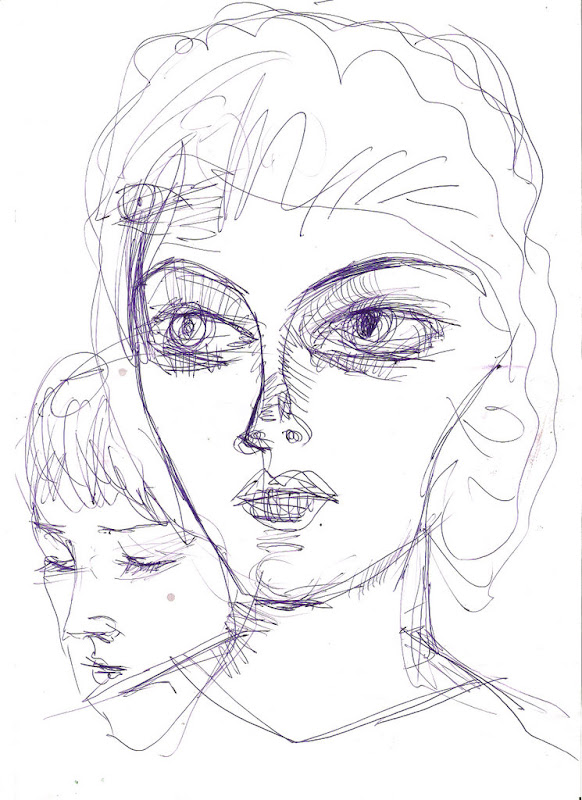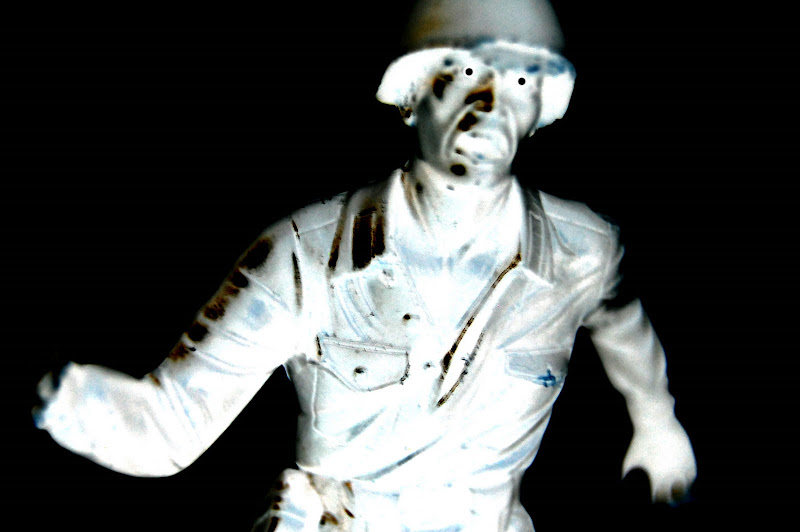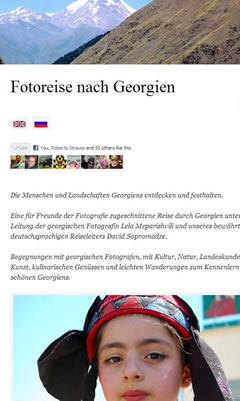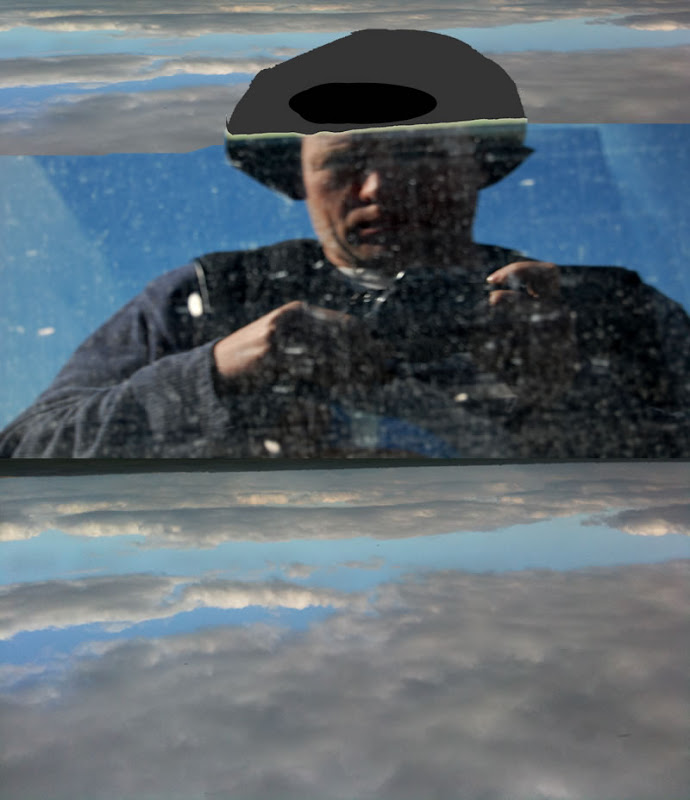 |
| From maerz2010 |
The best Blog on Art from the Caucasus, contributed and read worldwide + der Schützenpanzer unter den Kunstblogs + + Visuals Virtual Reality Caucasus Style + Net + Tbilisi and beyond
Wednesday, March 31, 2010
Monday, March 29, 2010
Sunday, March 28, 2010
Friday, March 26, 2010
Wednesday, March 24, 2010
Tuesday, March 23, 2010
Thursday, March 18, 2010
New paintings from 2009 by Maka Razmadze
| From Maka Razmadze Paintings |
| From Maka Razmadze Paintings |
| From Maka Razmadze Paintings |
| From Maka Razmadze Paintings |
| From Maka Razmadze Paintings |
| From Maka Razmadze Paintings |
| From Maka Razmadze Paintings |
| From Maka Razmadze Paintings |
| From Maka Razmadze Paintings |
Wednesday, March 17, 2010
Irina Gabiani on City Magazine Luxembourg, March 2010 issue, by Duncan Roberts
“City Magazine Luxembourg”, March 2010 issue,
“Faces: The news makers, decision takers, scene shakers ...”, “Awareness: Irina Gabiani,
visual Artist", by Duncan Roberts.
Photo by Julien Becker
“Faces: The news makers, decision takers, scene shakers ...”, “Awareness: Irina Gabiani,
visual Artist", by Duncan Roberts.
Photo by Julien Becker

Tuesday, March 16, 2010
Sunday, March 14, 2010
Saturday, March 13, 2010
The Language of Form is not the Form of Language. By Alexis Kazazis
Dear editors,
The following text was my response to a ‘call for participation’ for an exhibition project by an American visiting curator/artist to be held in the city of Thessaloniki, Greece. The curator’s name is Rachel Moore and her project is backed by the Fulbright Foundation. (You will find an attachment of Mrs. Moore’s text.)
Although I will not be participating in the actual exhibition, the specific ‘artist’s statement’ that I was required to submit does, in my view, touch upon the issues debated between Peter Plagens and Todd Richardson (letters to the editors, Art in America, Feb. 2010, p. 22), concerning the exhibition ‘Mississippi Yearning’. I couldn’t have visited (nor criticized) ‘Mississippi Yearning’, but I consider my arguments to [partly] contribute to your magazine’s relevant discourse.
In case you find my text impossible to edit to printable length, I would kindly ask you to forward it to Peter Plagens, as I hope he might find it worthwhile.
--------------------------------------------------------------
The Language of Form is not the Form of Language.
Far from being a post-structuralist blurb, the above axiom states, quite plainly, that the Vasarian thesis of the 'studiolo' artist-as-intellectual has reached its final stage in the 20th century, has lead to exaggerations and abuses from all sides and is rapidly disintegrating amidst an equally destabilized stock market economy of the so-called 'information age'. To borrow Gerhard Richter's words, "now that we do not have priests and philosophers [I add: or stockbrokers] anymore, artists are the most important people in the world". ('The Daily Practice of Painting', Thames & Hudson 1995, verso & p. 62)
I stress the word 'artists' as opposed to 'philosophers'. The distinction is of utmost importance. It is exactly the distinction between two ancient thinkers, Plato and Diogenes of Sinope, the first being a dualistic philosopher and the second a practical performer, an artistic activist, a philosophical terrorist, in short: a master of subversion. 'Defacing the currency' was, after all, the activity of a true Duchamp avant la lettre. (Platonism may have served the goals of the ruling classes ever since, but only as a Christianized myth of mind over matter, good and bad, master and servant, the division of labour.)
Duchamp himself has won a decisive victory on the issue of the meaning and function of art. The fatal blow he inflicted on the intellectual art establishment of his day (1917) has loosened the shackles of all artists after him. It is thanks to him that we (artists) may today define art and its context as arbitrarily as we please. Not forgetting that the self-professed (and thus supposed) enemy of painting went on to deliberately confuse every art bureaucrat of the century by continuing to use the medium of painting till the end of his life! (the 'Large Glass' is a painting, albeit an unusual one.)
But let’s return to language. How can an ‘artist’s statement’ serve the work of a visual artist? Must it function as the voluntary subordination of visual media (the image) to the philological constraints of text (written language)? Is Peter Haley’s blunder, namely to theorize his painting to death, not a useful lesson? Or should one verbalize about the anthropological, transcendental and emancipatory importance of art to society in the manner of Joseph Beuys? But Beuys' hot air declarations have done little if anything to stop the decay of his lumps of cold grease. And Marcel Broodthaers, the language artist par excellence, has long ago exposed the trappings of this self-styled art pope by openly addressing him with this epistle/artwork:
"Dear Wagner, ..., your essay 'Art and Revolution' - discussing magic, politics? - of which you are surely aware. The politics of magic? of beauty or of ugliness? - the Messiah! ... my dear Wagner, our relations have become strained ..."
Signed: Jacques Offenbach (1972)
[I am referring to Beuys the Icon, not to his merit as teacher.]
It has become commonplace to refer to 'cross-cultural dialogues', a 'cultural past', 'global and local issues', even 'political' engagement and evoking 'change'. Since curators are surely not Messiahs, I wonder why they should come up with discussion projects for people whose professional activity is not forging discussions (they are neither lawyers, nor scholars, nor party officials). Artists don't 'discuss' artworks, they make them. It is critics and scholars who discuss artworks, either to increase their market value (money is the name of the game) or, alternately, to serve the noble purposes of knowledge in the discipline of art history (the control of meaning). Artists do indeed discuss artworks among them and with anyone else they choose, but they do not call this an artwork. In the exception that an artist does so, he/she is solely responsible for any guidelines and principles.
So, why are we being asked to surrender our sovereignty and self-determination? Why are we asked to explain ourselves, our motives and our artworks? Why are we requested to perform as monkeys in the cage of textuality? Aren't our artworks eloquent enough as they are?
It is a rather unfortunate trend that artists opt to wrap themselves in the cloak of a scholar/curator/administrator. I must admit I know of only one single case that this has led to masterful success. When Hans Haacke – a New Yorker – mounted his exhibition project 'Viewing Matters' in Museum Boijmans in the Dutch city of Rotterdam (1999), he managed an unprecedented artistic achievement. The rigor and consequence of his museological deconstruction was such, that it remains unmatched (at least to my knowledge). [My Wagner/Offenbach citation came from p. 36 of the exhibition catalogue.]
But then Haacke set out to subvert, whereas others set out to control.
Let us suppose that the Fulbright Foundation (which some consider an agent of cultural neo-colonialism) enables an artist/curator to cross over the ocean and visit a somewhat ‘exotic’ corner of the old continent. This touristic corner (Greece), an economically unstable and culturally schizophrenic part of the East is supposed to belong to the current 'European Family' (EU) of the West. As Europe’s ‘poor relative’ it shares its neighboring Turkey's mentality in many things, but not religion. Significantly, we have no international artists of any prestige, unlike muslim countries like Turkey (or even Albania). Despite our Olympic Games fame, it would seem like we are yet to be ‘discovered’, so this place might be just right for the curious and aspiring ethnological [art] explorer: a virgin jungle full of colourful and cross-cultural Balkan baboons. That said, what can the civilized North-American art scout/missionary do in this fertile but uncultivated land? What can his/her modus operandi be?
By happy coincidence, the latest [February] issue of Art in America offers us a useful insight. From the letters to the editors [p. 22] I quote Peter Plagens, New York curator 'exploring' Mississippi:
"Any reasonable and conscientious curator/juror venturing onto unfamiliar turf wonders whether he or she picks the art selected because a) it's simply 'good' by some general standard that allows quirky stuff from a non-major contemporary art capital to come shining through, or b) it conforms to some procrustean bed the curator/juror, subconsciously or not, carts around everywhere."
Aside from Plagens’ option A (which disposes with any curatorial superiority and infallibility), the main question that arises here is what are the contents of that curatorial cart. Is it 'enlightenment'? Is it the 'brotherhood of man' (or a quasi-feminist variant thereof)? Is it the globalizing, post-metropolitan pseudo-philanthropy towards the [until recently] outsider 'ethnic' artist?
More often than not, an artist chosen for his ‘ethnicity’ or ‘otherness’ is expected to formulate ‘statements’ of ‘artistic’ justification, self-revelation (psychoanalysis?) and consent. Consent to an outmoded, conservative, and politically incorrect (in the true sense of the word) view of the world, art and artists. Any contrived verbal 'awareness' of ‘cultural pasts/influences/dialogues’ etc would totally castrate any evocative powers artworks might have, any perceptual enchantment they might achieve. This conceptual straightjacket already kills any possible magic. The baboon that stutters with a metropolitan [i.e. American] accent is a pitiful creature, a transvestite animal, a freak.
And this outmoded metropolitan quasi-scholasticism, an ancien regime of cultural politics can no longer be held credible. Since the baboon is an aggressive but intelligent animal, it might already know that “by conveying a thing through the medium of language, you change it. You construct qualities that can be said, and you leave out the ones that can’t be said but are always the most important.” (Gerhard Richter, above, p. 39)
That thing is the artwork itself. (ibid., p. 35)
Speaking of the ‘ethnicity’ of freaks and baboons, I am tempted to mention the achievement of two magnificent art buffoons: Gilbert & George.
G & G have consolidated the achievement of Marcel Duchamp. They scored a new victory, this time on the issue of the artist and his defiant self-determination. In 2007 they demolished, by sheer wit, the artificial division between Tate modern and Tate Britain, being the first 'British' artists to exhibit in a no-Brits institution. The Tate Britain has thus lost all of its teeth and its days are numbered. "We are not British artists", Gilbert & George declared, "we are artists [of the world]".
Similarly, this writer perceives himself as neither a Balkan nor a Greek, nor a left-wing or right-wing Greek artist. An artist is the mouthpiece of no one but him/herself. Art has nothing else to prove than that it is perceptually challenging and artistically (i.e. materially and aesthetically) consequent. In our current climate, this is already very political. Let’s face it: flogging October's dead horse cannot add impact to mediocre artworks.
Let me conclude with a few fitting words by Robert Storr (scholar, but also artist):
"Walter Benjamin ca. 1938, filtered through the crises of 1968, doesn't add up to 1988 or 1998, much less 2008. Nor is Lacan's distinctly mid-20th-century, and peculiarly French, rereading of Freud necessarily the best place to start a discussion of photography, or of feminist performance today - much less of digitally manipulated photography or abstract painting. If you're anxious about the rise of authoritarianism - and who isn't - then buck it. Don't just talk back to it in another authority-based language." (Art in America, May 2007, p. 111)
As for this writer’s awareness of his own 'cultural past': Diogenes of Sinope (ca. 412-323 BC) has gone down in history as the most insolent man that walked the face of this earth. He was Greek.
This is my heritage. And it's a global one.
Sincerely yours,
Alexis Kazazis
alexis.kazazis@gmail.com
Greece
The following text was my response to a ‘call for participation’ for an exhibition project by an American visiting curator/artist to be held in the city of Thessaloniki, Greece. The curator’s name is Rachel Moore and her project is backed by the Fulbright Foundation. (You will find an attachment of Mrs. Moore’s text.)
Although I will not be participating in the actual exhibition, the specific ‘artist’s statement’ that I was required to submit does, in my view, touch upon the issues debated between Peter Plagens and Todd Richardson (letters to the editors, Art in America, Feb. 2010, p. 22), concerning the exhibition ‘Mississippi Yearning’. I couldn’t have visited (nor criticized) ‘Mississippi Yearning’, but I consider my arguments to [partly] contribute to your magazine’s relevant discourse.
In case you find my text impossible to edit to printable length, I would kindly ask you to forward it to Peter Plagens, as I hope he might find it worthwhile.
--------------------------------------------------------------
The Language of Form is not the Form of Language.
Far from being a post-structuralist blurb, the above axiom states, quite plainly, that the Vasarian thesis of the 'studiolo' artist-as-intellectual has reached its final stage in the 20th century, has lead to exaggerations and abuses from all sides and is rapidly disintegrating amidst an equally destabilized stock market economy of the so-called 'information age'. To borrow Gerhard Richter's words, "now that we do not have priests and philosophers [I add: or stockbrokers] anymore, artists are the most important people in the world". ('The Daily Practice of Painting', Thames & Hudson 1995, verso & p. 62)
I stress the word 'artists' as opposed to 'philosophers'. The distinction is of utmost importance. It is exactly the distinction between two ancient thinkers, Plato and Diogenes of Sinope, the first being a dualistic philosopher and the second a practical performer, an artistic activist, a philosophical terrorist, in short: a master of subversion. 'Defacing the currency' was, after all, the activity of a true Duchamp avant la lettre. (Platonism may have served the goals of the ruling classes ever since, but only as a Christianized myth of mind over matter, good and bad, master and servant, the division of labour.)
Duchamp himself has won a decisive victory on the issue of the meaning and function of art. The fatal blow he inflicted on the intellectual art establishment of his day (1917) has loosened the shackles of all artists after him. It is thanks to him that we (artists) may today define art and its context as arbitrarily as we please. Not forgetting that the self-professed (and thus supposed) enemy of painting went on to deliberately confuse every art bureaucrat of the century by continuing to use the medium of painting till the end of his life! (the 'Large Glass' is a painting, albeit an unusual one.)
But let’s return to language. How can an ‘artist’s statement’ serve the work of a visual artist? Must it function as the voluntary subordination of visual media (the image) to the philological constraints of text (written language)? Is Peter Haley’s blunder, namely to theorize his painting to death, not a useful lesson? Or should one verbalize about the anthropological, transcendental and emancipatory importance of art to society in the manner of Joseph Beuys? But Beuys' hot air declarations have done little if anything to stop the decay of his lumps of cold grease. And Marcel Broodthaers, the language artist par excellence, has long ago exposed the trappings of this self-styled art pope by openly addressing him with this epistle/artwork:
"Dear Wagner, ..., your essay 'Art and Revolution' - discussing magic, politics? - of which you are surely aware. The politics of magic? of beauty or of ugliness? - the Messiah! ... my dear Wagner, our relations have become strained ..."
Signed: Jacques Offenbach (1972)
[I am referring to Beuys the Icon, not to his merit as teacher.]
It has become commonplace to refer to 'cross-cultural dialogues', a 'cultural past', 'global and local issues', even 'political' engagement and evoking 'change'. Since curators are surely not Messiahs, I wonder why they should come up with discussion projects for people whose professional activity is not forging discussions (they are neither lawyers, nor scholars, nor party officials). Artists don't 'discuss' artworks, they make them. It is critics and scholars who discuss artworks, either to increase their market value (money is the name of the game) or, alternately, to serve the noble purposes of knowledge in the discipline of art history (the control of meaning). Artists do indeed discuss artworks among them and with anyone else they choose, but they do not call this an artwork. In the exception that an artist does so, he/she is solely responsible for any guidelines and principles.
So, why are we being asked to surrender our sovereignty and self-determination? Why are we asked to explain ourselves, our motives and our artworks? Why are we requested to perform as monkeys in the cage of textuality? Aren't our artworks eloquent enough as they are?
It is a rather unfortunate trend that artists opt to wrap themselves in the cloak of a scholar/curator/administrator. I must admit I know of only one single case that this has led to masterful success. When Hans Haacke – a New Yorker – mounted his exhibition project 'Viewing Matters' in Museum Boijmans in the Dutch city of Rotterdam (1999), he managed an unprecedented artistic achievement. The rigor and consequence of his museological deconstruction was such, that it remains unmatched (at least to my knowledge). [My Wagner/Offenbach citation came from p. 36 of the exhibition catalogue.]
But then Haacke set out to subvert, whereas others set out to control.
Let us suppose that the Fulbright Foundation (which some consider an agent of cultural neo-colonialism) enables an artist/curator to cross over the ocean and visit a somewhat ‘exotic’ corner of the old continent. This touristic corner (Greece), an economically unstable and culturally schizophrenic part of the East is supposed to belong to the current 'European Family' (EU) of the West. As Europe’s ‘poor relative’ it shares its neighboring Turkey's mentality in many things, but not religion. Significantly, we have no international artists of any prestige, unlike muslim countries like Turkey (or even Albania). Despite our Olympic Games fame, it would seem like we are yet to be ‘discovered’, so this place might be just right for the curious and aspiring ethnological [art] explorer: a virgin jungle full of colourful and cross-cultural Balkan baboons. That said, what can the civilized North-American art scout/missionary do in this fertile but uncultivated land? What can his/her modus operandi be?
By happy coincidence, the latest [February] issue of Art in America offers us a useful insight. From the letters to the editors [p. 22] I quote Peter Plagens, New York curator 'exploring' Mississippi:
"Any reasonable and conscientious curator/juror venturing onto unfamiliar turf wonders whether he or she picks the art selected because a) it's simply 'good' by some general standard that allows quirky stuff from a non-major contemporary art capital to come shining through, or b) it conforms to some procrustean bed the curator/juror, subconsciously or not, carts around everywhere."
Aside from Plagens’ option A (which disposes with any curatorial superiority and infallibility), the main question that arises here is what are the contents of that curatorial cart. Is it 'enlightenment'? Is it the 'brotherhood of man' (or a quasi-feminist variant thereof)? Is it the globalizing, post-metropolitan pseudo-philanthropy towards the [until recently] outsider 'ethnic' artist?
More often than not, an artist chosen for his ‘ethnicity’ or ‘otherness’ is expected to formulate ‘statements’ of ‘artistic’ justification, self-revelation (psychoanalysis?) and consent. Consent to an outmoded, conservative, and politically incorrect (in the true sense of the word) view of the world, art and artists. Any contrived verbal 'awareness' of ‘cultural pasts/influences/dialogues’ etc would totally castrate any evocative powers artworks might have, any perceptual enchantment they might achieve. This conceptual straightjacket already kills any possible magic. The baboon that stutters with a metropolitan [i.e. American] accent is a pitiful creature, a transvestite animal, a freak.
And this outmoded metropolitan quasi-scholasticism, an ancien regime of cultural politics can no longer be held credible. Since the baboon is an aggressive but intelligent animal, it might already know that “by conveying a thing through the medium of language, you change it. You construct qualities that can be said, and you leave out the ones that can’t be said but are always the most important.” (Gerhard Richter, above, p. 39)
That thing is the artwork itself. (ibid., p. 35)
Speaking of the ‘ethnicity’ of freaks and baboons, I am tempted to mention the achievement of two magnificent art buffoons: Gilbert & George.
G & G have consolidated the achievement of Marcel Duchamp. They scored a new victory, this time on the issue of the artist and his defiant self-determination. In 2007 they demolished, by sheer wit, the artificial division between Tate modern and Tate Britain, being the first 'British' artists to exhibit in a no-Brits institution. The Tate Britain has thus lost all of its teeth and its days are numbered. "We are not British artists", Gilbert & George declared, "we are artists [of the world]".
Similarly, this writer perceives himself as neither a Balkan nor a Greek, nor a left-wing or right-wing Greek artist. An artist is the mouthpiece of no one but him/herself. Art has nothing else to prove than that it is perceptually challenging and artistically (i.e. materially and aesthetically) consequent. In our current climate, this is already very political. Let’s face it: flogging October's dead horse cannot add impact to mediocre artworks.
Let me conclude with a few fitting words by Robert Storr (scholar, but also artist):
"Walter Benjamin ca. 1938, filtered through the crises of 1968, doesn't add up to 1988 or 1998, much less 2008. Nor is Lacan's distinctly mid-20th-century, and peculiarly French, rereading of Freud necessarily the best place to start a discussion of photography, or of feminist performance today - much less of digitally manipulated photography or abstract painting. If you're anxious about the rise of authoritarianism - and who isn't - then buck it. Don't just talk back to it in another authority-based language." (Art in America, May 2007, p. 111)
As for this writer’s awareness of his own 'cultural past': Diogenes of Sinope (ca. 412-323 BC) has gone down in history as the most insolent man that walked the face of this earth. He was Greek.
This is my heritage. And it's a global one.
Sincerely yours,
Alexis Kazazis
alexis.kazazis@gmail.com
Greece
Labels:
Alexis Kazazis,
Art Theory
Wednesday, March 10, 2010
Tuesday, March 9, 2010
Some new paintings by Nugzari Natenadze and Hans Heiner Buhr
 |
| From maerz2010 |
 |
| From maerz2010 |
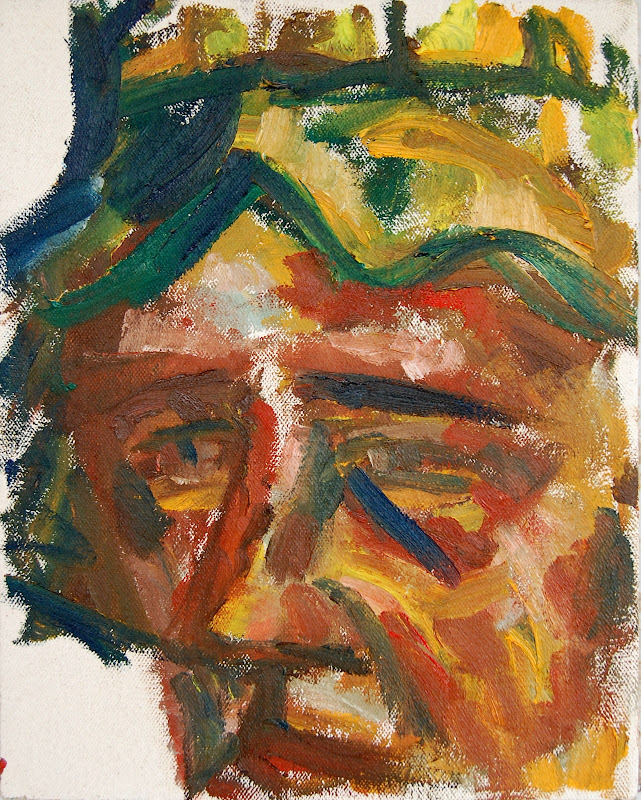 |
| From maerz2010 |
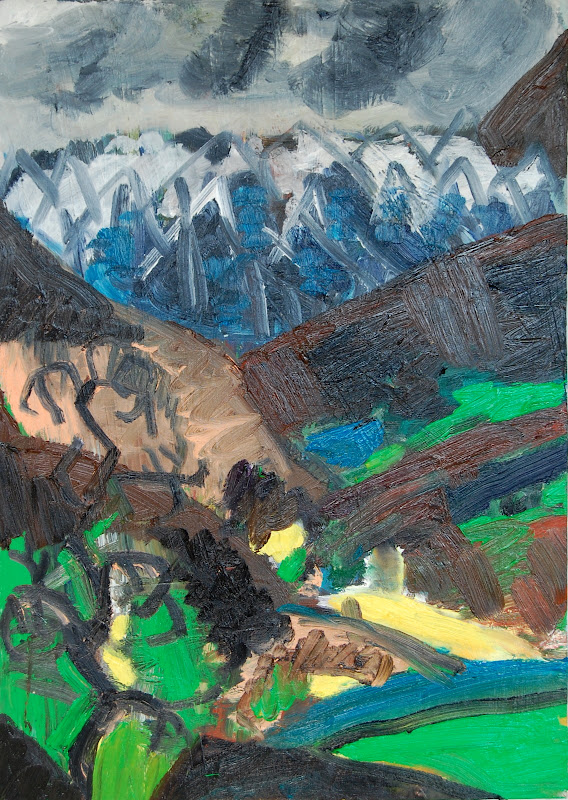 |
| From maerz2010 |
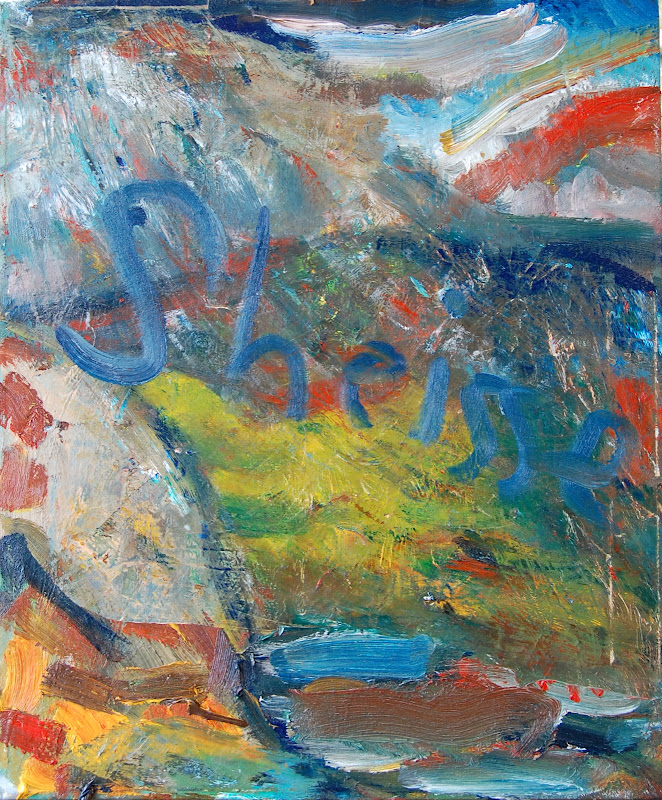 |
| From maerz2010 |
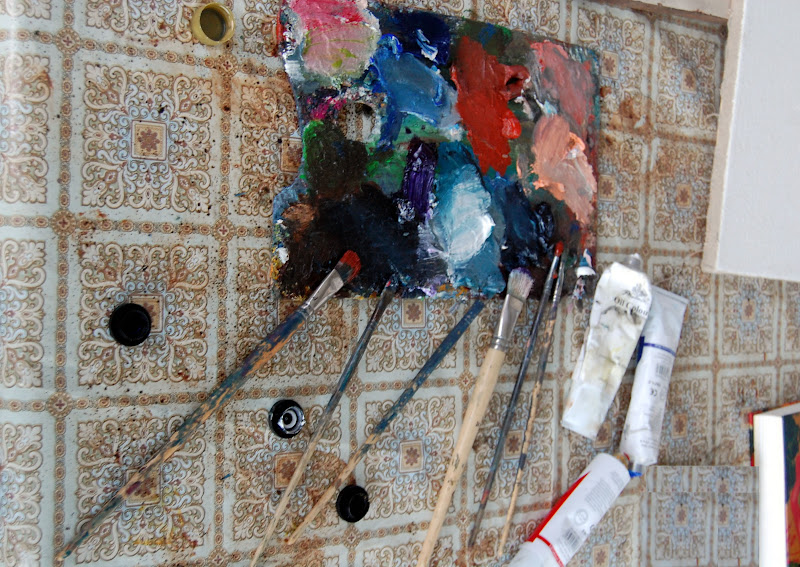 |
| From maerz2010 |
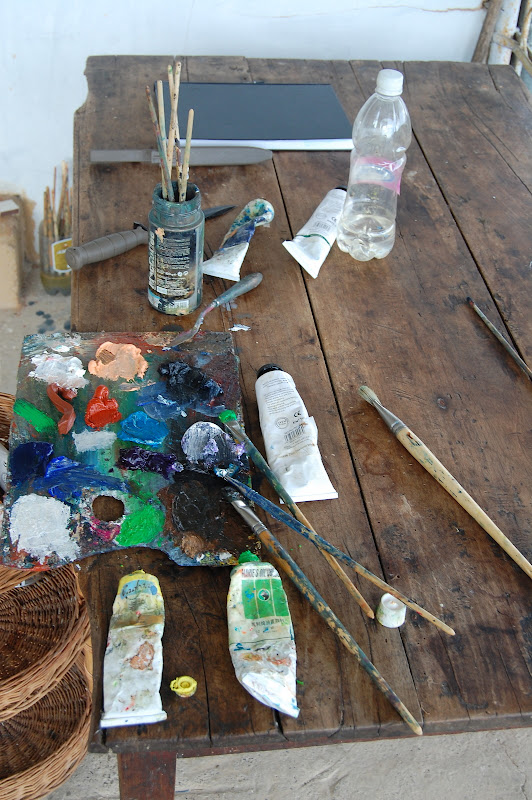 |
| From maerz2010 |
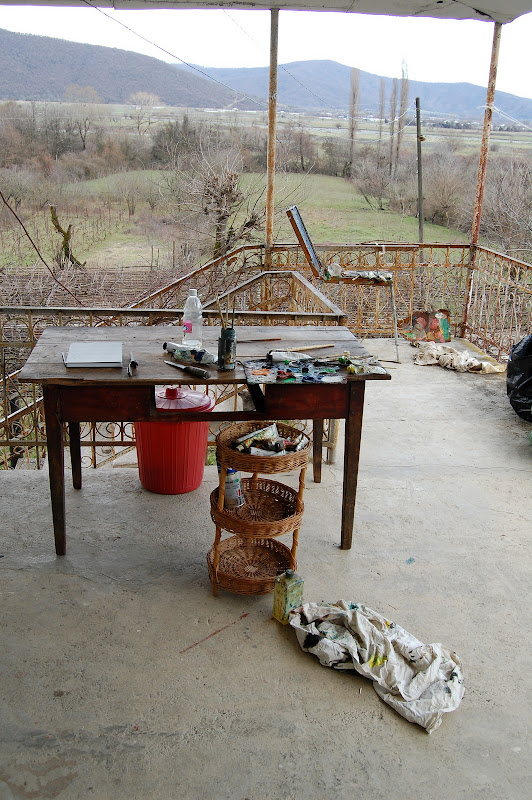 |
| From maerz2010 |
 |
| From maerz2010 |
 |
| From maerz2010 |
Heiner and Nugzari
Labels:
abstract painting,
Hans Heiner Buhr,
Kakheti,
landscape,
Nugzari Natenadze,
Pona
Subscribe to:
Posts (Atom)
